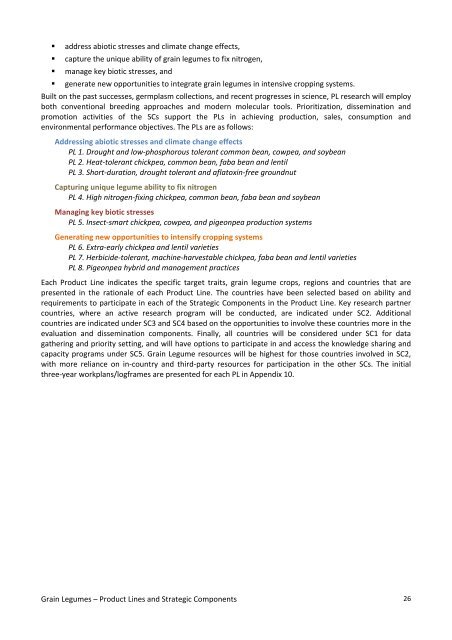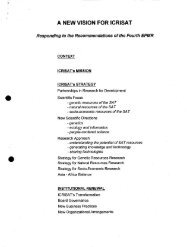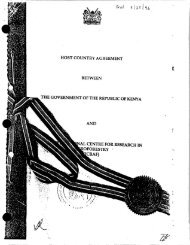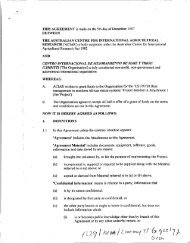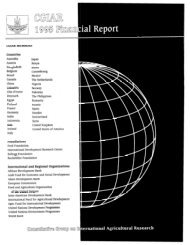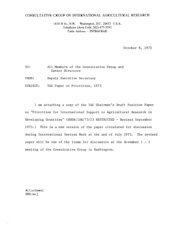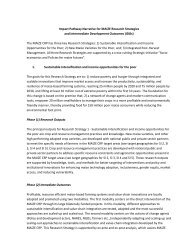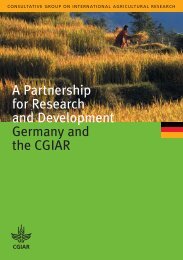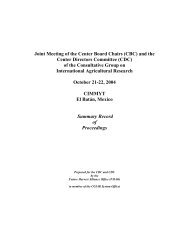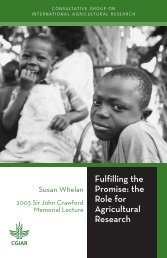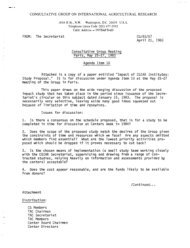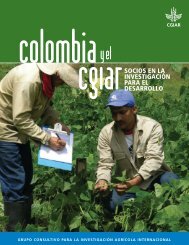CGIAR Research Program on Grain Legumes: Proposal - Library
CGIAR Research Program on Grain Legumes: Proposal - Library
CGIAR Research Program on Grain Legumes: Proposal - Library
- No tags were found...
Create successful ePaper yourself
Turn your PDF publications into a flip-book with our unique Google optimized e-Paper software.
• address abiotic stresses and climate change effects,• capture the unique ability of grain legumes to fix nitrogen,• manage key biotic stresses, and• generate new opportunities to integrate grain legumes in intensive cropping systems.Built <strong>on</strong> the past successes, germplasm collecti<strong>on</strong>s, and recent progresses in science, PL research will employboth c<strong>on</strong>venti<strong>on</strong>al breeding approaches and modern molecular tools. Prioritizati<strong>on</strong>, disseminati<strong>on</strong> andpromoti<strong>on</strong> activities of the SCs support the PLs in achieving producti<strong>on</strong>, sales, c<strong>on</strong>sumpti<strong>on</strong> andenvir<strong>on</strong>mental performance objectives. The PLs are as follows:Addressing abiotic stresses and climate change effectsPL 1. Drought and low-phosphorous tolerant comm<strong>on</strong> bean, cowpea, and soybeanPL 2. Heat-tolerant chickpea, comm<strong>on</strong> bean, faba bean and lentilPL 3. Short-durati<strong>on</strong>, drought tolerant and aflatoxin-free groundnutCapturing unique legume ability to fix nitrogenPL 4. High nitrogen-fixing chickpea, comm<strong>on</strong> bean, faba bean and soybeanManaging key biotic stressesPL 5. Insect-smart chickpea, cowpea, and pige<strong>on</strong>pea producti<strong>on</strong> systemsGenerating new opportunities to intensify cropping systemsPL 6. Extra-early chickpea and lentil varietiesPL 7. Herbicide-tolerant, machine-harvestable chickpea, faba bean and lentil varietiesPL 8. Pige<strong>on</strong>pea hybrid and management practicesEach Product Line indicates the specific target traits, grain legume crops, regi<strong>on</strong>s and countries that arepresented in the rati<strong>on</strong>ale of each Product Line. The countries have been selected based <strong>on</strong> ability andrequirements to participate in each of the Strategic Comp<strong>on</strong>ents in the Product Line. Key research partnercountries, where an active research program will be c<strong>on</strong>ducted, are indicated under SC2. Additi<strong>on</strong>alcountries are indicated under SC3 and SC4 based <strong>on</strong> the opportunities to involve these countries more in theevaluati<strong>on</strong> and disseminati<strong>on</strong> comp<strong>on</strong>ents. Finally, all countries will be c<strong>on</strong>sidered under SC1 for datagathering and priority setting, and will have opti<strong>on</strong>s to participate in and access the knowledge sharing andcapacity programs under SC5. <strong>Grain</strong> Legume resources will be highest for those countries involved in SC2,with more reliance <strong>on</strong> in-country and third-party resources for participati<strong>on</strong> in the other SCs. The initialthree-year workplans/logframes are presented for each PL in Appendix 10.<strong>Grain</strong> <strong>Legumes</strong> – Product Lines and Strategic Comp<strong>on</strong>ents 26


